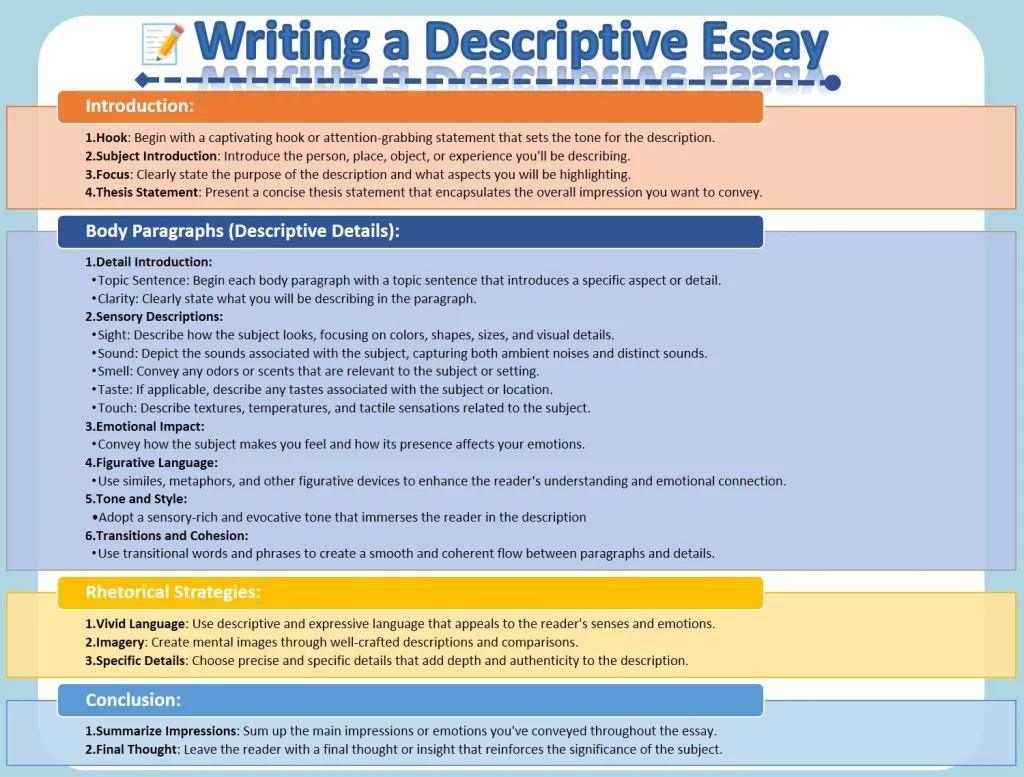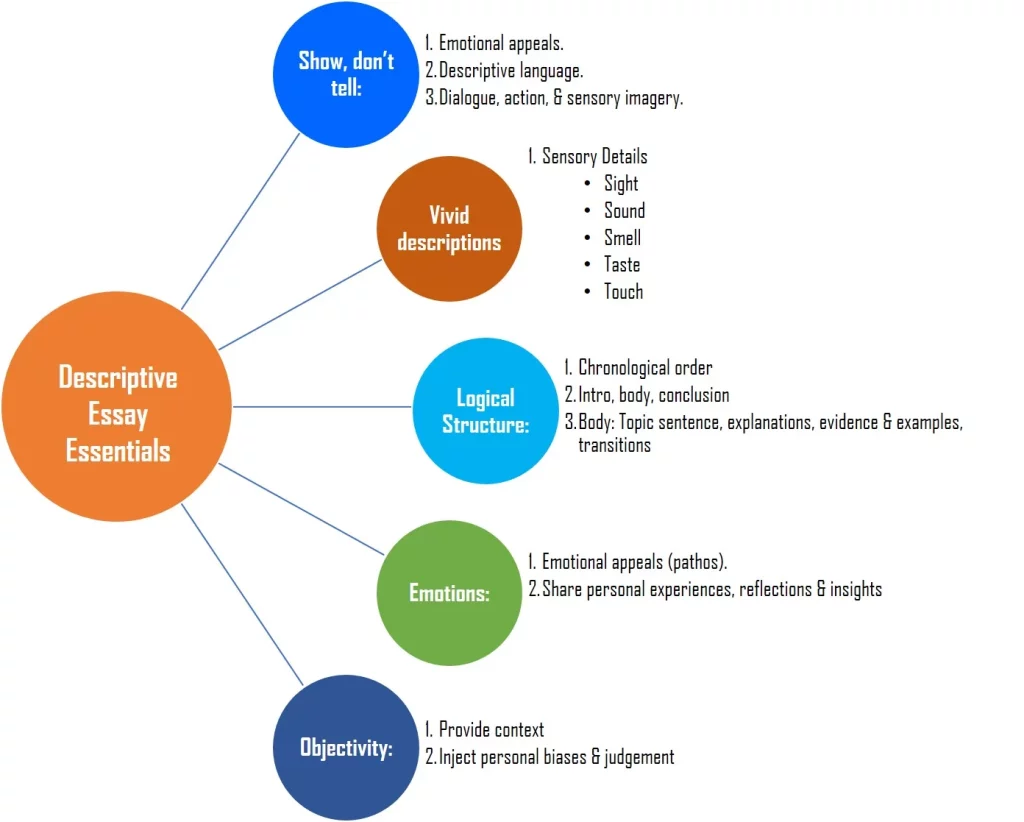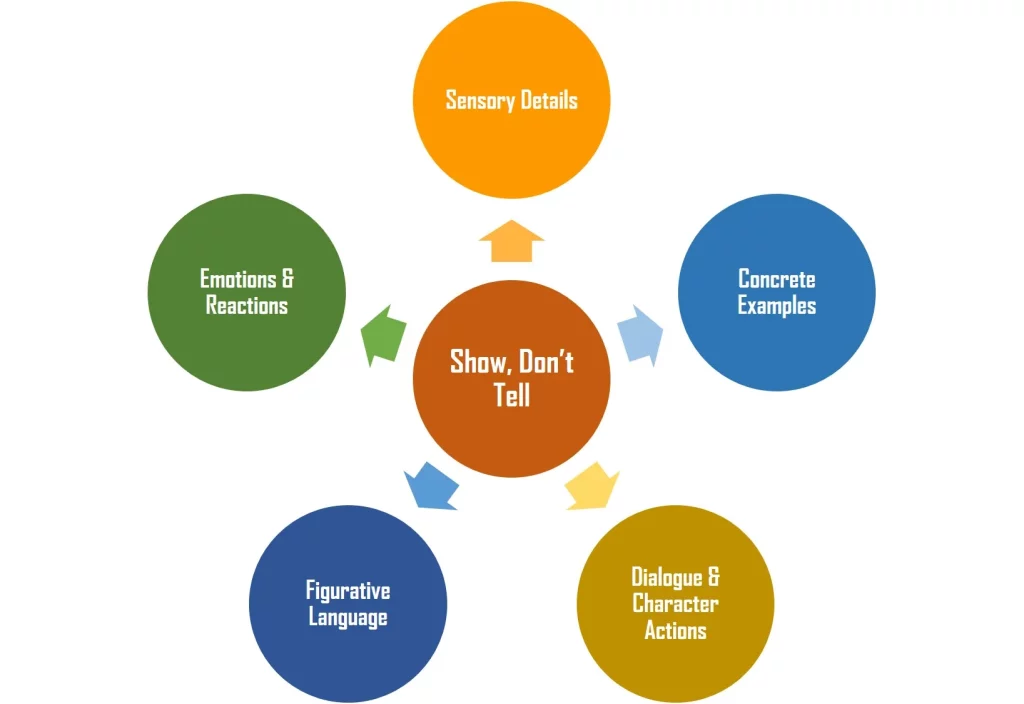
A descriptive essay is a type of academic or creative writing that focuses on describing a particular person, place, object, event, or experience in detail. The primary goal of a descriptive essay is to provide a vivid and sensory-rich portrayal of the subject to help the reader form a clear mental picture of it. Unlike other types of essays, such as argumentative or persuasive essays, descriptive essays do not aim to convince or persuade the reader of a specific point of view but rather to create a sensory experience through words.
Here are excellently crafted sample descriptive essays tailored for both high school and college students:
Sample Descriptive Essay: Exploring the Ancient Ruins of Machu Picchu
Sample Descriptive Essay: A Cozy Winter Evening by the Fireplace
Key Features

Here are some key features of a descriptive essay:
- Vivid Language: Descriptive essays use rich and evocative language to create a sensory experience for the reader. This includes using sensory details such as sight, sound, touch, taste, and smell to convey the subject’s characteristics.
- Clear Organization: A well-structured descriptive essay typically follows a chronological or spatial organization, which means it may describe the subject from top to bottom, left to right, or in a logical sequence that makes sense to the reader.
- Use of Figurative Language: Writers often use metaphors, similes, and other forms of figurative language to enhance the description and create more vivid imagery.
- Emotional Impact: A descriptive essay can also evoke emotions in the reader by describing the subject in a way that connects on a personal or emotional level.
- Show, Don’t Tell: Instead of simply stating facts about the subject, a descriptive essay shows the reader what the subject is like through detailed and sensory descriptions.
- Attention to Detail: Descriptive essays require attention to small details that contribute to the overall picture, making the subject come alive for the reader.
- Objective Description: While some personal reflection or interpretation may be included, the primary focus of a descriptive essay is to objectively describe the subject, allowing the reader to form their own impressions.
Common topics for descriptive essays include describing a memorable place, a person who has had a significant impact on your life, an important event, a work of art, a natural landscape, and more. The key is to engage the reader’s senses and imagination, allowing them to experience the subject through your words.
General Outline
The format of a descriptive essay typically follows a standard essay structure, including an introduction, body paragraphs, and a conclusion. Here’s a basic outline of the format:
- Title:
- Create a descriptive and engaging title that gives the reader a hint of what the essay is about.
- Format it as per citation guidelines provided i.e. APA, MLA, etc.
- Introduction:
- Begin with a hook or an engaging opening sentence that introduces the subject you will describe.
- Provide some background information or context about the subject.
- Present a clear and concise thesis statement that summarizes what you will be describing in the essay.
- Body Paragraphs (Usually 3-5 paragraphs):
- Each body paragraph should focus on a specific aspect or feature of the subject.
- Start each paragraph with a topic sentence that introduces the main idea or characteristic you will describe.
- Use descriptive language and sensory details to vividly depict the subject.
- Organize your paragraphs logically. You might choose to describe the subject in a spatial or chronological order, moving from one detail to the next in a coherent manner.
- Transition smoothly between paragraphs to maintain the flow of the essay.
- Conclusion:
- Summarize the main points or features you described in the body paragraphs.
- Reiterate the significance or importance of the subject, especially if it relates to a personal experience or memory.
- End with a closing statement that leaves a lasting impression on the reader or offers a final insight or reflection.
- Citations:
- For each in-text citation, provide a corresponding reference entry
- Follow citation guidelines provided by your instructor/ academic institution.
It’s essential to use descriptive language effectively to paint a clear and vivid picture for the reader. Sensory details, figurative language, and precise word choices can significantly enhance the descriptive quality of your essay.
How to Write: Steps
Writing a descriptive essay involves creating a detailed and vivid portrayal of a particular subject, place, person, or event through words. Here’s a step-by-step guide for high school and college students on how to write a descriptive essay:
- Choose a Topic: Select a topic that holds personal significance or appeals to the senses. It should be something you can describe in detail. Common topics include a favorite place, a memorable experience, a person you admire, or an object of importance.
- Brainstorm and Gather Details: Before you start writing, brainstorm and make a list of all the sensory details, emotions, and observations related to your chosen topic. Think about what you want your readers to visualize, feel, hear, smell, or taste.
- Create an Outline: Develop an outline to organize your thoughts and ideas logically. An outline typically includes an introduction, body paragraphs, and a conclusion. Plan which details you’ll include in each section.
- Write an Engaging Introduction:
- Begin with a hook: Grab the reader’s attention with a compelling opening sentence.
- Provide some background information about your topic.
- Include a clear thesis statement that conveys the main purpose of your essay.
- Craft Descriptive Body Paragraphs:
- Each paragraph should focus on a specific aspect or detail related to your topic.
- Use vivid and descriptive language to paint a picture in the reader’s mind.
- Appeal to the five senses (sight, sound, smell, taste, touch) to create a sensory experience.
- Organize details logically, such as moving from general to specific or following a chronological order.
- Include figurative language and literary devices like similes, metaphors, and personification to enhance your descriptions.
- Show, Don’t Tell: Instead of simply telling the reader about your subject, show it through sensory details and concrete examples. Allow the reader to experience what you’re describing.
- Use Transitions: Employ transitional words and phrases to guide the reader through your essay smoothly. These words help create a coherent and flowing narrative.
- Write a Strong Conclusion:
- Summarize the main points made in your essay.
- Reiterate the significance of your topic or reflect on its impact.
- Leave a lasting impression on the reader by reinforcing the emotions or images you’ve evoked.
- Revise and Edit:
- Review your essay for clarity, coherence, and grammar.
- Check for spelling and punctuation errors.
- Ensure that your descriptions effectively convey your intended message.
- Get Feedback: Share your essay with someone else, such as a friend, family member, or teacher, and ask for their feedback. They can provide valuable insights and suggestions for improvement.
- Finalize Your Essay: Make any necessary revisions based on the feedback you receive. Proofread your essay one last time before submitting it.
Remember that the key to a successful descriptive essay is to engage the reader’s senses and emotions, allowing them to connect with the subject on a deeper level through your vivid descriptions.
Show, Don’t Tell

“Show, don’t tell” is a fundamental principle in writing, including descriptive essays. It means that instead of directly stating facts or information, you should use vivid and specific details to paint a picture for the reader. By doing so, you allow the reader to draw their own conclusions and immerse themselves in the scene or experience you’re describing. Here’s a more detailed explanation:
- Use Sensory Details: Engage the reader’s senses by describing what can be seen, heard, smelled, tasted, or touched. For example, instead of saying, “It was a hot day,” you can describe, “The sun beat down mercilessly, causing sweat to trickle down our foreheads and the pavement to radiate waves of heat.”
- Concrete Examples: Provide concrete examples, objects, or actions that illustrate the abstract concepts or qualities you want to convey. Instead of stating, “She was brave,” you can describe a situation where she displayed bravery, allowing the reader to deduce her bravery themselves.
- Dialogue and Character Actions: Instead of telling the reader about a character’s personality, let their actions and dialogues reveal it. For instance, instead of saying, “He was a kind-hearted person,” you can show his kindness through his interactions with others or his selfless acts.
- Metaphors and Similes: Use metaphors and similes to create comparisons that evoke a vivid image or feeling. For instance, “Her smile was as bright as the morning sun,” creates a clear mental image.
- Emotions and Reactions: Instead of telling the reader how a character feels, describe their physical and emotional reactions to a situation. This allows the reader to empathize and connect with the character’s emotions. For example, instead of stating, “She was heartbroken,” you can describe how she cried, clutched her chest, and whispered his name.
In a descriptive essay, “show, don’t tell” is essential for creating a more immersive and engaging experience for the reader. It enables them to connect with the subject matter on a deeper level and make their own inferences based on the details and experiences you provide.
Writing Tips: Dos and Don’ts
Here are the most essential considerations when writing a descriptive essay, along with dos and don’ts for each:
- Show, Don’t Tell:
- Do: Instead of explicitly stating facts or emotions about the subject, use descriptive language and concrete details to allow the reader to infer those facts or emotions. Show the reader what the subject is like through vivid descriptions.
- Do: Use dialogue, action, and sensory imagery to convey information and create a more immersive experience for the reader.
- Don’t: Provide a list of characteristics or attributes without illustrating them with specific examples or sensory details.
- Don’t: Use vague or abstract statements that leave the reader guessing about the subject’s qualities or significance.
- Vivid Language and Sensory Details:
- Do: Use descriptive language that appeals to the reader’s senses (sight, sound, touch, taste, and smell) to create a vivid and immersive experience.
- Do: Incorporate specific sensory details to help the reader visualize the subject.
- Don’t: Overwhelm the essay with excessive adjectives and adverbs; use descriptive words thoughtfully and sparingly.
- Don’t: Rely solely on general or abstract descriptions that do not engage the senses.
- Clear and Organized Structure:
- Do: Organize your essay logically, often following a spatial or chronological order to describe the subject effectively.
- Do: Use topic sentences at the beginning of each body paragraph to introduce the main idea of that section.
- Don’t: Jump randomly between details without a clear structure or order.
- Don’t: Clutter the essay with unrelated information that does not contribute to the overall description.
- Emotional Impact and Engagement:
- Do: Evoke emotions in the reader by choosing descriptive elements that resonate on a personal or emotional level.
- Do: Share personal reflections or insights when relevant to enhance the emotional connection.
- Don’t: Force emotions or exaggerate descriptions to manipulate the reader’s feelings.
- Don’t: Stray too far from the primary goal of creating a descriptive experience by delving into unrelated narratives.
- Objective Description:
- Do: Maintain objectivity in your descriptions, allowing the reader to form their own impressions of the subject.
- Do: Provide relevant background information when necessary to give context to the description.
- Don’t: Inject personal biases or judgments into the description unless it is explicitly part of the essay’s purpose.
- Don’t: Use the essay solely as a platform for personal opinions or arguments; the primary focus should be on describing the subject.
Remember that the balance between these characteristics can vary depending on the specific topic and purpose of your descriptive essay. Always consider your audience and the intended effect you want to achieve with your writing while adhering to the guidelines above.
Frequently Asked Questions (F.A.Qs)
Here are answers to the frequently asked questions about descriptive essays:
-
Descriptive Essay vs. Narrative Essay:
- A descriptive essay focuses on providing detailed descriptions of a subject, place, person, or event. It aims to paint a vivid picture using sensory details.
- A narrative essay, on the other hand, tells a story with a clear plot, characters, and a chronological sequence of events. It may also include descriptions but primarily focuses on storytelling.
-
How do I choose a suitable topic for my descriptive essay?
- Choose a topic that has personal significance or emotional value to you.
- Consider subjects that evoke strong sensory experiences or emotions.
- Reflect on places, people, objects, or moments that you can describe in rich detail.
-
What are some effective techniques for creating vivid descriptions in my essay?
- Use sensory language to engage the reader’s five senses (sight, sound, smell, taste, touch).
- Employ figurative language such as metaphors, similes, personification, and symbolism.
- Show, don’t tell; use concrete examples and specific details.
- Organize your descriptions logically, moving from general to specific or following a clear pattern.
-
What are some examples of sensory details for a descriptive essay?
- Sight: “The vibrant red leaves danced in the gentle autumn breeze.”
- Sound: “The waves crashed against the shore with a soothing rhythm.”
- Smell: “The aroma of freshly baked bread wafted through the air.”
- Taste: “The rich, creamy chocolate melted on my tongue.”
- Touch: “The rough bark of the ancient oak tree felt cool and textured beneath my fingertips.”
-
What are some examples of descriptive and figurative language for a descriptive essay?
- Descriptive Language: “The old, weathered book had yellowed pages and a faint musty odor.”
- Figurative Language (Metaphor): “Her laughter was a melody that filled the room.”
- Figurative Language (Simile): “The sunset was like a blazing fire on the horizon.”
-
How can I make my descriptive essay more engaging and captivating to the reader?
- Start with an attention-grabbing introduction or a captivating hook.
- Create a strong emotional connection between the reader and the subject.
- Vary sentence structure and length to maintain reader interest.
- Use descriptive language that elicits emotions and connects with the reader’s experiences.
-
Are there any specific rules or guidelines for using sensory details in a descriptive essay?
- Ensure sensory details are relevant to the overall theme and purpose of the essay.
- Use sensory language sparingly and strategically, focusing on the most impactful details.
- Avoid overloading the essay with sensory descriptions that might overwhelm the reader.
-
How can I craft a strong thesis statement for a descriptive essay?
- A thesis statement in a descriptive essay should convey the main impression or message you want to leave with the reader.
- It should summarize the essence of your description or the significance of your subject.
- Example: “The bustling farmers’ market is a vibrant and sensory-filled microcosm of community life.”
-
How can I revise and edit my descriptive essay to improve its quality?
- Review for clarity, coherence, and grammar.
- Remove unnecessary details or redundancies.
- Ensure your descriptions align with the overall theme and purpose.
- Seek feedback from others to gain different perspectives on your essay.



